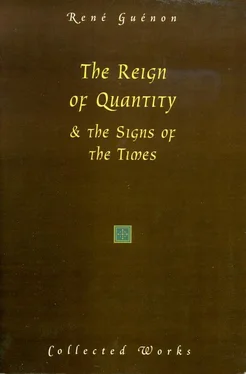A very clear example of this sort of thing can be found in a case such as that of ‘shamanism’, which is generally regarded as one of the typical forms of ‘animism’; the derivation of the word is rather uncertain, but it is generally used to denote the aggregate of the traditional doctrines and practices of certain Mongol peoples of Siberia, though a few people extend its meaning to cover anything that may present similar features in any country. Many people regard ‘shamanism’ as almost synonymous with sorcery, but it certainly should not be so, for the two things are quite distinct; the word has undergone a deviation opposite to that of ‘fetishism’, which really has etymologically the meaning of ‘sorcery’, but has been applied to things that include nothing of the kind. It may be noted in this connection that the distinction some people have tried to establish between ‘shamanism’ and ‘fetishism’, regarded as being two varieties of ‘animism’, is neither as clear nor as important as they think: whether human beings, as in the first case, or various objects, as in the second, chiefly serve as ‘supports’ or ‘condensers’, if that is the right word, for certain subtle influences, the difference is only one of ‘technical’ modalities involving in themselves no truly essential differences. [121] In what follows, a certain amount of information about ‘shamanism’ is drawn from an exposition called ‘Shamanism of the Natives of Siberia’ by I. M. Casanowicz (taken from the Smithsonian Report for 1924) to which the author’s attention was kindly called by A. K. Coomaraswamy.
If we consider ‘shamanism’ properly so called, the existence of a highly developed cosmology becomes apparent, of a kind that might suggest concordances with other traditions in many respects, and first with respect to a separation of the ‘three worlds’, which seems to be its very foundation. ‘Shamanism’ will also be found to include rites comparable to some that belong to traditions of the highest order: some of them, for example, recall in a striking way the Vedic rites, and particularly those that are most clearly derived from the primordial tradition, such as those in which the symbols of the tree and of the swan predominate. There can therefore be no doubt that ‘shamanism’ is derived from some form that was, at least originally, a regular and normal traditional form; moreover it has retained up to the present day a certain ‘transmission’ of the powers necessary for the exercise of the functions of the ‘shaman’; but as soon as it becomes clear that the ‘shaman’ directs his activity particularly toward the most inferior traditional sciences, such as magic and divination, a very real degeneration must be suspected, such as may sometimes amount to a real deviation, as can happen all too easily to such sciences whenever they become over-developed. There are indeed some rather disquieting indications in that direction, one of them being the connection established between the ‘shaman’ and an animal, a connection restricted to a single individual and so in no way assimilable to the collective connection rightly or wrongly called ‘totemism’. It should be added that all this could in itself receive a perfectly legitimate explanation quite unconnected with sorcery; what gives it a suspicious character is the fact that among some peoples, if not among all, the animal is considered as being more or less a form of the ‘shaman’ himself; and there may be no great distance between an identification of that kind, and ‘lycanthropy’ as it exists more particularly among the black races. [122] There is evidence worthy of belief to the effect that there exists in a distant part of the Sudan a whole population of at least twenty thousand people who are ‘lycanthropic’; there are also, in other African countries, secret organizations, such as that to which the name of ‘Society of the Leopard’ was given, in which certain forms of lycanthropy play a predominant part.
But there is something else as well, and something more directly connected with our subject: from among the psychic influences with which they deal, the ‘shamans’ quite naturally distinguish two kinds, one benefic and the other malefic, and as there is obviously nothing to be feared from the former, they pay attention almost exclusively to the latter: such at any rate appears most often to be the case, though it may be that ‘shamanism’ includes various forms that might show differences in that respect. But there is never any question of a ‘cult’ devoted to the malefic influences, which would be a sort of conscious ‘satanism’, as has often been wrongly imagined; the only objective is, in principle, that of preventing them from doing harm, or of neutralizing or diverting their activity. The same could be said with truth of other supposed ‘devil-worshippers’ living in various places: in a general way it is scarcely likely that real ‘satanism’ could be characteristic of an entire people. Nevertheless, it is still true that, whatever may be the original intention, the handling of influences of this sort, when no appeal is made to influences of a superior order (still less to truly spiritual influences), finally leads by force of circumstances to real sorcery, which is a very different thing of course from the sorcery of the common ‘rustic magician’ of the West, for this last represents no more than the last scraps of a magical knowledge as degenerate and diminished as it could be, and on the point of complete extinction. The magical part of ‘shamanism’ doubtless has a vitality of quite a different order, and that is why it is something really to be feared in more than one respect; for the practically constant contact with inferior psychic forces is as dangerous as could be, first for the ‘shaman’ himself, as is to be expected, but also from another point of view of a much less narrowly ‘localized’ interest. There are indeed people who, by working more consciously and with a more extensive knowledge (and this does not mean knowledge of a higher order) might be able to make use of these same forces for quite different ends, unbeknown to the ‘shamans’ or those whose work is similar, for they act as nothing more than mere instruments for accumulating the forces in question at pre-determined points. It is known that there are in the world a certain number of ‘repositories’ of influences, the distribution of which is certainly no matter of chance, serving only too well the designs of the ‘powers’ responsible for the whole modern deviation; but that demands some further explanations, for it may seem surprising at first sight that the remains of what was once an authentic tradition should lend themselves to a ‘subversion’ of this kind.
The last point mentioned in connection with ‘shamanism’ needs to be clarified, for it contains the main reason for the introduction of the subject; for this purpose it must be made clear that the case of the persistent vestiges of a degenerate tradition that has lost its superior or ‘spiritual’ part is fully comparable to the case of the psychic remains left behind by a human being in passing to another state, for these remains can be used for any purpose once they have been abandoned by the ‘spirit’. Whether they be made use of consciously by a magician or a sorcerer, or unconsciously by spiritualists, the more or less malefic effects that can accrue obviously have nothing to do with the inherent character of the being to whom they belonged before; they are no longer anything but a special category of ‘wandering influences’, to use the terminology of the Far-Eastern tradition, and they have kept at the most a purely illusory likeness to the said being. Comparisons of this kind can only be fully understood if it is remembered that even spiritual influences themselves must necessarily, if they are to come into action in our world, take appropriate ‘supports’, first of all in the psychic order, then in the corporeal order itself, so that the result is something analogous to the constitution of a human being. If later on the spiritual influences for any reason withdraw themselves, their former corporeal supports, whether places or objects (and when places are in question their situation is naturally connected with the ‘sacred geography’ mentioned earlier) will nonetheless remain charged with psychic elements that will be all the stronger and more persistent through having previously served as the intermediaries and the instruments of a yet more powerful action. It would be logical to conclude that important traditional and initiatic centers, more or less long since extinct, must in general be the most important potential sources of danger, whether arising from violent reactions provoked in the psychic conglomerates persisting in such places by sheer imprudence, or more especially from the seizure of these elements by ‘black magicians’, to use the accepted expression, who could then manoeuvre them at will in order to obtain results conforming to a plan.
Читать дальше











